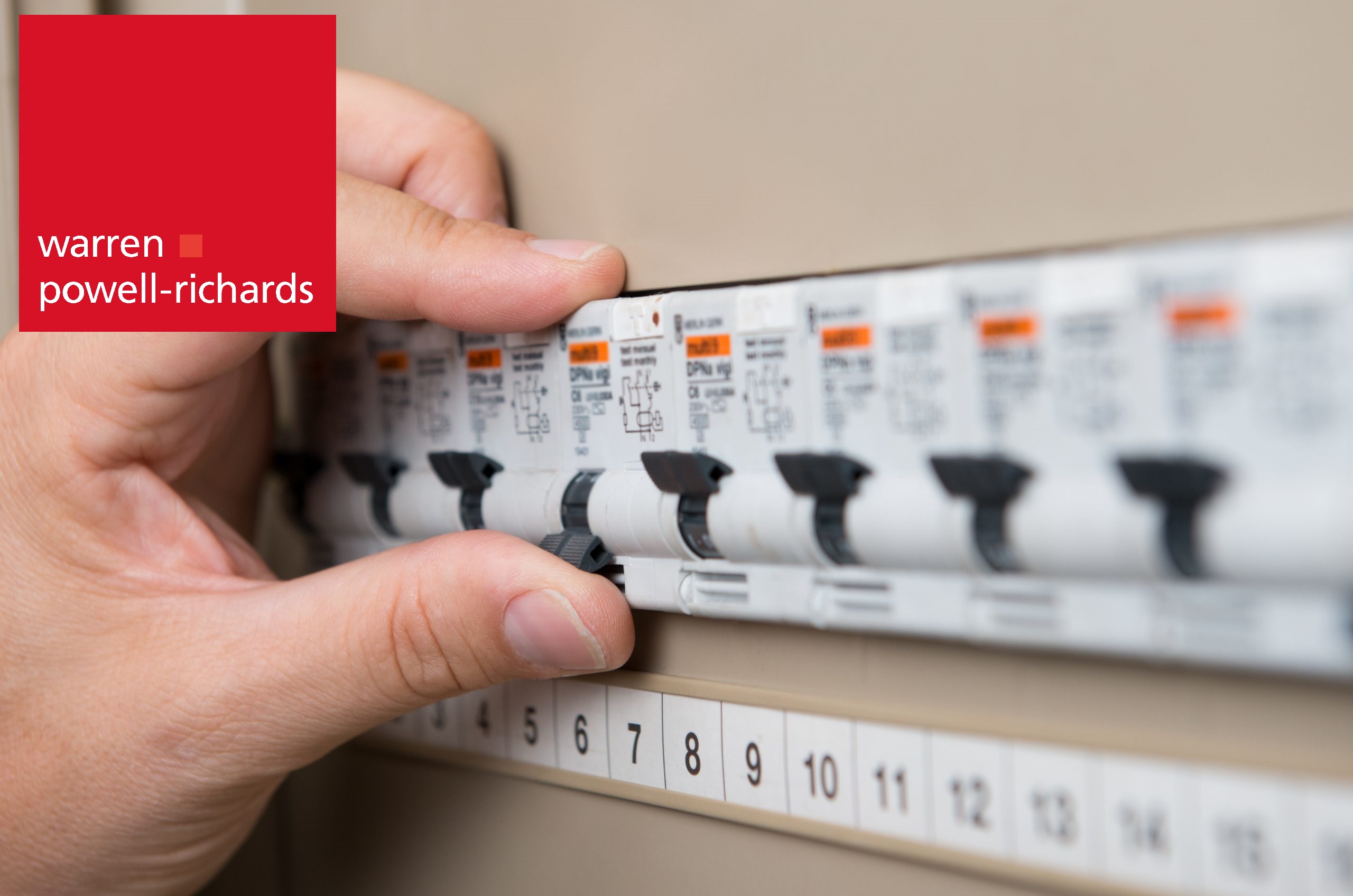Blog
- Details
- Hits: 805

Your 6 Step Guide to the Conveyancing Process
Finding the house of your dreams is exciting and your next step is to secure the property as soon as possible. But buying a new home can be a complex process, particularly when it comes to understanding the conveyancing procedure.
Here at Warren Powell-Richards we always endeavour to ensure your sale and purchase runs smoothly, with no surprises along the way. So, with this in mind, we have created a no-jargon guide to the conveyancing process to help you.
But, first things first.
What is conveyancing?
Conveyancing is the legal term for the transfer of home ownership between a buyer and seller. The process begins once your offer is accepted on your chosen property and completes when you have the keys in your hand on moving day! This conveyancing process is absolutely essential to ensure that all the legalities of your sale or purchase are covered and to make certain the transfer of ownership happens with as little stress as possible.
Who does the conveyancing?
Although you can do it yourself, we always recommend that the conveyancing process is undertaken by a professional solicitor or a conveyancer as it can be a multifaceted process. You’ll need to instruct a legal professional as soon as your offer on a property is accepted, so it’s wise to make enquiries and carry out due diligence so that you have several options ready and can start the process without delay. Once you have chosen and appointed a conveyancer or solicitor, they will draw up a draft contract and advise you of their charges.
The 6-step Conveyancing Process
Step 1: Initial contact is made between legal representatives
The first task undertaken by your solicitor or conveyancer will be to contact your seller’s legal representative to request a copy of the draft contract, the property’s title and other standard forms. Your solicitor or conveyancer will thoroughly examine these documents and raise any initial queries. They will also action a number of ‘searches’ to make sure there are no issues you need to be aware of that are not in plain sight. The most common searches are local authority searches, environmental searches and drainage and water searches.
Step 2: Mortgage and survey requirements are confirmed
At this point, if you need one, you should make sure your mortgage is in place as your solicitor or conveyancer will require a copy of your mortgage offer for the next stage of the conveyancing process.
You will also be required to get a mortgage valuation. This is carried out on behalf of your mortgage lender and is to satisfy the lender that the property is secure against the amount of money they are loaning you.
A necessary survey may also be required at this stage. Whilst not a legal requirement, whether you decide to instruct a survey on the property or not will depend on both the property and your specific circumstances.
Step 3: Contracts are signed
Once all the searches have completed, queries have been answered, you have provided your mortgage offer and are satisfied with the survey that has been carried out on the property, your solicitor will agree details regarding the transfer of your deposit funds along with a completion date. You will then be ready to sign the contract in preparation for exchange and completion.
Step 4: Contracts are exchanged
Next comes the exciting part! Exchange of contracts between buyer and seller. Your deposit will be paid on exchange and at this time you will be in a legally binding contract. The good news is that the seller can no longer accept another offer on the property and must sell the property to you. However, if you back out of the purchase at this stage, you will lose your entire deposit. There is usually a deliberate delay between exchange and completion to allow the deeds to the property to be transferred into your name.
Step 5: Finally, it’s completion day!
Completion is usually set for 12 noon or 2pm on the agreed date, however, in reality it can happen as soon as the sellers’ solicitor confirms that all monies have been received. You can then collect your keys to your new home from us – a moment that always makes us smile!
Step 6: The final legal work is completed
Whilst you move into your new property, your solicitor or conveyancer will tie up all the loose ends from a legal perspective. They will ensure stamp duty is paid on your behalf, send your title deeds to your mortgage lender and make sure you receive copies of your legal documents.
They will also send you your final bill for legal work undertaken.
Now all that is left for you to do is to unpack, settle into your dream home and enjoy your perfect surroundings.
If you require further independent advice, help and assistance regarding the conveyancing process, the Warren Powell-Richards team are happy to help.
- Details
- Hits: 833

First Time Buyer? 4 Easy Ways to Improve Your Credit Score
When you take out your first mortgage, as with any financial product, you’ll have to go through a credit check. It’s normal to feel apprehensive about this process, as let’s face it, few of us have perfect credit.
That’s why it’s worth trying to improve your credit score, if possible, in the months before you apply for a mortgage, as a better score can mean lower rates and a wider choice of lenders.
With this in mind, here are four ways you can improve your credit score.
- Get a copy of your credit report
There are lots of free and paid for credit report services in the UK, enabling you to access your information. We recommend you go directly to the three main credit reference agencies; Experian, Equifax and Callcredit. When running your credit check, your lender or broker will usually use one or a combination of these services.
Once you have your credit report, check it carefully for errors. It’s important to do this well in advance of applying for your mortgage, as it can take a while for changes to take effect. Some things that could be dragging down your credit rating include:
- Not being on the electoral register
- Late or missing bill payments
- Taking out a lot of credit in comparison to income
- Being financially linked to someone with bad credit, i.e. an ex partner
Whilst you can’t erase a bad credit history, you can draw a line under it and become better with money, as well as correcting any mistakes that are bringing down your score.
- Borrow responsibly
There’s one thing that can be just as worrying to lenders as a bad credit history, and that’s having no credit history at all. If you live with your parents and have never had a loan, credit card or car payments, then it’s possible you may have barely any credit history. This may seem like a good thing to you, but the reasons why lenders might find this troublesome is that they don’t know if you’re any good at handling money! If you’ve never had to balance a budget and pay off a utility bill every month, then how do they know if you can cope with making mortgage payments?
The simplest solution to this is to borrow small amounts and pay them off monthly, before the interest charges kick in. Get a credit card and use it for your day-to-day expenses, paying it in full each month. This will help you build a credit score. Just be careful not to be tempted to overspend.
- Don’t max out cards – and do pay more than the monthly minimum
When you apply to borrow money, whether it’s a credit card or car finance, you get a credit limit, which is the maximum amount a lender will be willing to lend you. It’s important to realise that this is a limit, not a goal, so never go over it. Try to pay down any credit cards and loans as much as possible before you apply for a mortgage, as having cards close to their limit instantly lowers your score.
You should also make sure you pay more than the minimum each month on credit cards. If you pay the minimum, you’re just paying off the interest, so your debt never really goes down. There are online calculators that you can use to work out how long it will take to pay off your cards, so take a look at what a difference an extra payment of £10 or £20 per month can make to your overall balance.
- Pay on time
If you’re the type who pays their bills whenever they remember, and regularly misses payments by a few days, then get out of bad financial habits now. Draw up a spreadsheet of your outgoings and which day they are due, and make sure that you pay bills a few days before this to allow the payments time to go through. If making manual payments is a pain, then consider setting up direct debits that debit your account soon after payday, so there’s no excuse to miss any.
Getting a better credit score can help you as a first time buyer, enter the mortgage market. It shows that you’re responsible with money and gives you a better opportunity to see the best mortgage deals. Many first time buyers only have a small deposit, so may be looking to borrow 90-95% of a property’s value, and to get these kinds of mortgages, you’ll need a great credit rating and no adverse credit on your file.
- Details
- Hits: 539

How to Furnish Your Home on a Budget
Choosing furnishings for your home on a tight budget can be challenging! So how do you furnish your home on a budget?
Well, there are plenty of small steps you can take to make your home look fantastic without breaking the bank.
The key to success is taking your time, making informed decisions, and not rushing the process.
Love What You Already Have
When you buy a new home, there can be pressure and desire to furnish it entirely from scratch, without considering what you already have.
Often, some of your current possessions just need a little bit of love and attention to leave them looking brand new.
Armchairs can be reupholstered to leave them looking unique and fresh, at a fraction of the cost of buying a new one. Wooden items such as pine tables and old cabinets can be stained, varnished, or painted to give them a new lease of life.
Hunt Down Second-Hand Gems
Gone are the days that second-hand shopping meant spending hours searching charity shops high and low.
Some fantastic furniture pieces can be found online, such as on the Facebook, Gumtree, and eBay marketplaces. Many items sell for way under their market value; some are even given away for free.
Scouring these sites can take a little time, and you should always look with an open mind. People are often giving away items that are as good as new because they simply lack the space to keep them any longer.
However, when second-hand shopping, be sure you are choosing pieces that you love. When you see heavy discounts or even free items, it can be tempting to snap them up without stopping to consider whether you want them, or you are just grabbing it because it’s a ‘bargain’.
Prioritise Your Purchases
Contrary to what you might have seen on social media, furnishing a home fully can often take many months, sometimes years.
This is especially relevant when you are working with a tight budget.
To get your home looking great, you must not rush the process. Otherwise, you could end up making unwise decisions and being disappointed with the final look.
When on a budget, it is vital to prioritise key pieces that you or your family simply cannot live without. Basic items such as a sofa, beds and a dining table are probably top of your list, with other items capable of waiting for a few months.
Try to remove the pressure from yourself to furnish the whole home, or entire rooms at once. It is perfectly normal to dress your home piece by piece, and it can be gratifying watching everything come together.
Mix ‘Pricey with Inexpensive‘
A handy tip for furnishing a property on a budget is to vary your price points. Choosing one staple luxury piece for a room and mixing it with inexpensive items can help transform any space.
When choosing your luxury pieces, try and stick to neutral shades which will work with your budget pieces. For example, choose a neutral sofa then add pops of colour with inexpensive cushions, throws and rugs.
Neutrals are Best
Choosing neutral furniture is a must for those on a budget. With neutral pieces, you can move them around your home, switching and changing rooms as the year’s pass.
This can be particularly relevant if you are furnishing your home in stages. Without a clear vision for each room, neutral pieces allow you to move the furniture around in the months and years to come.
Paint is Your Best Friend
Painting rooms might seem straightforward, but the impact it can make on your home is huge. Fresh paint, using excellent quality materials will lift a room and bring it all together.
Whilst bright whites will accentuate the natural light in your home, dark colours add the wow factor. Do not be afraid of using black, navy and deep green to add an extra element to every room.
You might also consider using removable wallpaper. This is a great option for renters or those on a budget who prefer to wait until funds are available for a full refurb.
Cohesion is Key
The key to elevating your home, and making it look more luxurious, is cohesion. There should be a consistent theme running throughout the house, showing you have put consideration and effort into your styling. For example similar textured fabrics in each room.
This does not have to mean that every room adheres to the same colour scheme, but simple nods to a consistent identity will go a long way towards making a budget home look pricey.
- Details
- Hits: 468

Electrical Safety Inspections: Everything Landlords Need to Know
When you are a landlord, you should remember that people actually live in your property! It’s more than just bricks and mortar and an investment. It’s ultimately someone’s home.
There lies within property ownership a responsibility to tenants to make sure that they are safe. Indeed, it’s an obligation, and it’s a legal responsibility too.
For years, landlords have had to carry out regular gas safety checks, but new rules now mean that landlords must carry out electrical safety checks too.
Here, we set out what they’re all about.
What’s Changed?
The Government, which says it acknowledges many landlords are responsible owners, said it wants to make sure people are safe when they live in rented accommodation.
So, new guidelines were drafted, and those new rules came into force in June 2020 as the Electrical Safety Standards in the Private Rented Sector (England) Regulations 2020.
At the time, the Government said: “This is a major step towards levelling up the private rented sector, making sure it will offer high-quality, safe and secure housing.”
This is good thinking, and a welcome move, particularly when you consider that gas safety checks have been carried out for years now.
What do the new Rules Mean?
Landlords must now comply with the new regulations. They must have “the electrical installations in their properties inspected and tested by a person who is qualified and competent, at least every five years”.
A copy of the electrical safety report must be provided to tenants, and also to a local authority (like the council) if requested.
Basically, electrical testing has got to be done by professionals with the correct knowledge and skill.
Does this Apply to all of a Landlord’s Properties?
The new regulations must be adhered to, but there are two dates to be mindful of. The rules apply to new tenancies from July 1, 2020. This means for new tenancies that commenced after July 1, a safety report should already have been carried out. However, landlords have until April 1, 2021, for existing tenancies.
Can Anyone do an Inspection?
No. As the guidelines say, the inspection must be carried out by a competent person who is registered to do so. You can find a list of professionals here www.electricalcompetentperson.co.uk
What do the Inspections Cover?
Inspections are not about fridges of kettles or other small appliances or white goods. What they about are the fixed electrical things like plug sockets and lights, and also showers if they are electric and permanently fixed.
Tests will see if everything is safe or if there is a risk of fire or an electric shock. It’s pretty easy to see why an inspection needs to be done – and that is to protect life and property. Depending on what an inspection finds, action may or may not be required. Landlords must then carry out the work within a specified time, and there must be written evidence of this.
What Happens if Electrics Remain Unsafe?
Responsible landlords will want to get any electrical issues fixed and will take action to make good anything highlighted in the inspection report immediately. In the guidelines, if work is not carried out, local councils have the authority to serve a remedial notice on a landlord who must then get the job done. If they don’t, and the council is confident that landlord duties have been breached, it can inform the landlord that it intends to impose a fixed penalty – and this could be up to £30,000.
It makes good business sense to ensure properties are inspected, and it’s a legal duty now too, so we recommend that landlords get started and make sure their properties have been inspected.
Chances are, you’ll have been working with people you trust, but you must ensure they are competent. If you are unsure, use the website www.electricalcompetentperson.co.uk to check if a tradesperson you know is registered.
If you are a landlord and have any queries at all, it’s better to be safe than sorry. Get in touch with us here at Warren Powell-Richards and we’ll run through the details with you.
- Details
- Hits: 518

How to Move Home Stress Free
According to a recent survey, 60%* of Brits have put off looking for a new home purely because of the pressures involved with the moving process.
Furthermore, 34% said that they had suffered severe anxiety as a result of their last move and 65% experienced sleeping problems.
However, it doesn’t have to be such a terrible ordeal.
Moving home should, and can, be an exciting time. A chance to start afresh, seek out new opportunities and make your new property your own.
Research removal companies
You are going to be moving all your worldly possessions from your old home to your new one, so you need to make sure that they are in safe hands. Therefore, it is vital that you spend time researching removal companies in advance to ensure you find a reputable and trustworthy company.
If possible, ask family and friends for recommendations as well as reading a variety of online reviews from previous customers. It is a good idea to choose two or three removal firms to provide you with quotations before the big day so that you achieve a competitive price and know your moving needs will be adequately catered for.
Have a thorough clear out
Now is the ideal time to get rid of any unwanted belongings, such as furniture that won’t fit or be required in your new home, any clutter that has been piling up in the back of your cupboards, and basically any items that are surplus to your needs. Don’t forget about the garden, the loft (if you have one) and any outdoor storage areas.
Make a packing plan
You may think that you can get your packing completed in a matter of days, but sadly, this exciting, yet arduous task always takes longer than you think it will! Especially if you want to pack effectively so that the unpacking process in your new home can be carried out quickly.
It is a good idea to use colour labelling on your moving boxes, for example, blue for the bathroom, yellow for the kitchen and so on. Work your way systematically through each room, including the garden, and complete the packing for that room or area before moving onto the next.
Take care of all moving admin
You will have enough to deal with on the big day without having to worry about locating paperwork, or carrying out vital administrative tasks that could have been taken care of weeks earlier.
Before moving to a new house you should:
- Redirect your post – you can sign up to Royal Mail’s redirection service if you need more time to contact all your providers.
- Transfer school records. If you have children that will be attending a new school, you should ensure their school records are sent over before you move.
- Ensure you are insured for moving. Check to see if your belongings insurance covers a house move and if not, ask your removal company if they can provide further cover.
- Inform your utility companies about your move, including your home insurance providers. You should also take the gas, electricity and water meter readings before you leave your property.
- Confirm your moving day. This may seem an obvious task, but you will be surprised by how many people forget to do this.
- You also need to ensure that you have details regarding the collection of keys to your new property from your estate agent.
Source a survival kit
If you want to have a smooth and stress-free journey from your old home to your new one, then you will need a moving day survival kit. This should include supplies that you will need throughout the day, so you do not need to go rummaging through your packed boxes.
Items you may want to include are:
- Important documents such as information relating to your new home, contact details of your removal company, and any relevant insurance documents
- Mobile phone chargers
- Bottles of water and snacks
- Games or devices to keep the kids occupied
- Pet feeding bowls, food, toys and lead
- Tea, coffee and a kettle
- Loo roll!
It is also recommended that you pack a basic overnight bag so that you will have access to clean clothes, toiletries, medications, and snacks for the next morning.
Your survival kit will ensure you are organised on moving day and ready to start unpacking boxes in your new home stress free!





ALTON | FARNHAM | GODALMING | GRAYSHOTT | HASLEMERE | LONDON